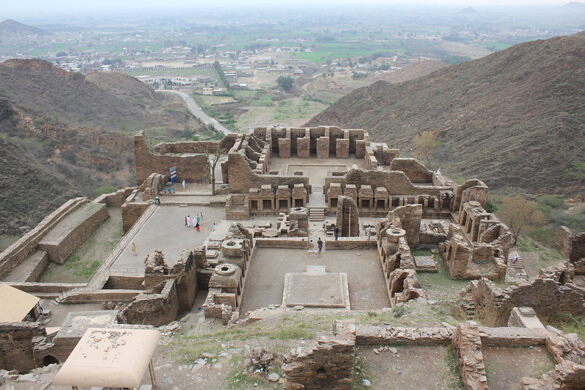Takht-i- Bahi Buddhist Monastery, Pakistan.

Address
Takht-i- Bahi Buddhist Monastery, Mazdoorabad, Takht Bhai, Mardan, Khyber Pakhtunkhwa, Pakistan.
Diety
Buddha
Introduction
The ruins are located about 15 kilometres from Mardan in Pakistan’s Khyber-Pakhtunkhwa Province. The Buddhist monastery was founded in the 1st century CE, and was in use until the 7th century. The complex is regarded by archaeologists as being particularly representative of the architecture of Buddhist monastic centers from its era. Takht-i-Bahi was listed as a UNESCO World Heritage Site in 1980. The ruins of Takht-i-Bahi still retain the structure of the typical Gandhara Buddhist Temple, which includes the Main Stupa Court, the votive Stupa court, the monastery, meditation room and other structures. There are 35 consecrated stupas lined up in a row between the South Tower and the North Monastery. Now, only the base of the structure is left. The base is decorated with Greek styled columns. This is the monastery. There were 15 small cells surrounding the courtyard, each cell having a wall with a lamp on it, and some having a second floor. There is also what looked to be the remnants of a kitchen on the edge of the courtyard
Puranic Significance
During the 5th and 6th century, when the Huns of Central Asia were expanding their empire across modern day Pakistan and Afghanistan, Buddhist sites were destroyed by the hundreds. Some monasteries and temples escaped the brunt of the attack, thanks to their relatively inaccessible locations. One of these was the Takht-i-Bahi monastery, an important Buddhist site even today. Takht, in Persian means throne, and bahi means spring, and this throne of springs is situated in the higher reaches of the Mardan province in Pakistan. Though it sustained some damage, it is among the most well preserved early Buddhist sites in the region. It was built as a small stone monastery in the 1st century, and one of the earliest inscriptions found refers to Gondophares, the Indo-Parthian king of the time. Under the patronage of the rulers of different dynasties who followed, more structures were added to the original premises. Over the next 800 years, it developed into a large Buddhist complex, one of the most influential in the region, and it was supported by the nearby fortified town of Sahr-i-Bahlol. The town’s residents regularly carried offerings and food for the monks who lived at Takht-i-Bahi.
Century/Period/Age
7th century CE
Managed By
UNESCO World Heritage Site
Nearest Bus Station
Takhat Bhai
Nearest Railway Station
Takhat Bhai
Nearest Airport
Risalpur




